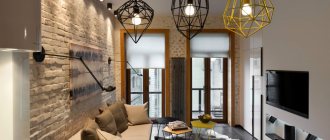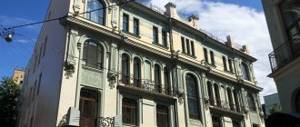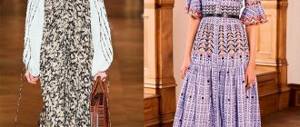High speed capsule transport system
Jumping into a high-speed capsule that will fly thousands of kilometers through a series of tubes sounds like a pipe dream, but the project is not too far from reality. Hyperloop was the idea of Tesla Motors founder Elon Musk several years ago. Today, enterprising people have taken over the Hyperloop and are already preparing to build an experimental pipe. The high-speed transportation system involves pressurized capsules that float on a cushion of air along a continuous steel tube. Such a system can cover a 500-kilometer route in 35 minutes at speeds of up to 1,000 kilometers per hour. Twice slower than on an airplane. The pods can accommodate six to eight people, which will depart every 30 seconds and cost just $20 per ticket. The project price is $6.2 billion. This is a lot, but comparable in price to high-speed rail and highways.
Airplane on rails
How could travel change if we could combine rail with flying? Studio Globe's Horizon System reinvents our transportation system, demonstrating the ability to move from land to air seamlessly and seamlessly. At the passenger SkyStation you can step on the SkyLink step. Passengers are then whisked away in this "pod" that is attached to the SkyShip. What is noteworthy is that these platforms will contain not only passengers with luggage, but also fuel for the aircraft. It turns out that the plane will never have to land. And if it doesn't have to land, its wings can be optimized directly for flight, greatly increasing its efficiency.
Melting Point TV Stand Accessories
Designer Erhan Afsaroglu's Melting Point TV Stand was inspired by the sight of an ordinary drop of water before it reaches the surface. The concept of this furniture is made of high-max from LG - an artificial acrylic stone for decorative finishing. When the Melting Point TV Stand shelves hang on the wall, they seem to literally float in the air. The effect is enhanced by the built-in LED backlight.
House of Sun
While solar powered homes are nothing new, making them sustainable and modular is not easy. Developed by students from more than 40 universities under Team Sweden, Halo is a concept for a sustainable residential building powered entirely by solar energy. 95% of the construction materials are made from renewable wood. Halo includes more than 30 isolated modules that are discreetly attached to each other. The one-piece roof consists of solar panels that provide energy to the house.
3D printed dentures
3D printing has already come a long way in just a few years.
Industrial designer William Root reinforces this point with his Exo-Prosthetic, a state-of-the-art prosthetic that can be 3D printed. Although similar products are already invading our world, the concept deserves attention and reflects the spirit of the times. Getting a regular denture can sometimes be quite difficult and expensive. Ruth uses modern technology to streamline the production of prosthetics. It uses a combination of a 3D scanner, a 3D printer, and sophisticated 3D modeling software to create a precise, customizable, and affordable prosthesis. The final model is printed from titanium. It is not only cheaper and easier, but also aesthetically pleasing. As Root himself puts it, “One of the most common complaints you hear from amputees is the look of their new prosthetics. Traditional prosthetics are robotic and mechanical in nature. By using 3D printing, I give more freedom to the form. The most important aesthetic aspect is to merge with the physical form of the wearer. This allows us to create more natural and pleasing prosthetics that fit well with clothing and help the wearer physically feel the shape of the lost limb.”
House on the Tides
Can you imagine a home in the future that lives solely on ocean waves? Designer and architect Margo Krasozevic has unveiled the “hydroelectric tidal house,” a futuristic concept that harnesses the power of tidal waves to generate electricity. The building is covered with two shells, external and internal. The outer one is made of concrete and contains solar panels that provide electricity to the living area. The shell is riddled with hydraulic turbines that generate electricity from tidal waves. The inner shell, made of lightweight aluminum, rises and settles with changing tides. The outer shell acts as something like an anchor for it. The outer shell is more flexible and responds to the movement of the pistons of hydraulic turbines. Tidal waves as an energy source have not yet been studied in the context of self-sustaining houses. However, the architect believes they can be more “efficient” by working in symbiosis with wind and solar energy.
Science fiction designers or futuristic clothing style
science fiction style futurism
4/21/2016, 9:39 views
In our world, one way or another, everything is interconnected and each sphere of human activity and life leaves its mark on the other. Likewise, the fashion industry constantly “keeps its finger on the pulse”, tracking global changes in art, politics, high technology or in the social mood of society.
When the avant-garde movement Futurism emerged in Italy in 1909, it penetrated almost every sphere of cultural life. And fashion, of course, was no exception. People are tired of constantly returning to the past, of patterns and rules. They wanted to dream about a bright and fantastic future, strive for something new and progressive, destroy stereotypes and move forward, without looking back.
The ideological leader of the Futurists was the Italian writer Filippo Marinetti, who wrote the first propaganda work “Manifesto of Futurism” and was the founder of a number of futurist-themed magazines. And in 1913, the Italian artist Giacomo Balla wrote and published “Manifesto on the Clothes of the Man of the Future,” where he called for introducing into everyday fashion bright colors, dynamic prints and use scientific discoveries in sewing production - innovative technological materials and technologies. Technical progress, space exploration, modernization - these are the things that the futurists promoted. By the way, the philosophy of this avant-garde movement was actively supported in Russia, where interest in it did not subside for fifteen years, although Russian couturiers created futuristic clothes purely for the stage or film industry.
According to the views of futurists, clothing should not only be practical, comfortable and beautiful, but also necessarily ergonomic, mega-functional and high-tech. When creating clothes, it is necessary to use the latest developments and high-tech materials. In addition to basic functions, things should protect (from moisture, cold, wind, injuries), help improve well-being, aerodynamic functions of the body, and even monitor its condition.
Directly in fashion, futurism began to actively develop in the 60s of the 20th century, when technological progress reached extraordinary heights. And the conquest of outer space excited not only children's imaginations, but also inspired fashion designers to create fashion collections of the future. Graceful and sophisticated clothing silhouettes were replaced by clear, geometric ones, and thin high heels were replaced by flat soles. The colors used were either bright or silver and white. Among the pioneers of futuristic collections were Andre Courrages, Pierre Cardin, and the well-known Paco Rabanne.
When many of the ideas of the futurists, which had previously shocked, but later took root, became the norm, the movement began to lose its strength and meaning. This happened in the 70s of the 20th century and lasted until 2003, when the futuristic style of clothing again entered the fashion arena and moved forward in the toga, having won a strong place among fashion trends. And in the spring-summer 2020 season, futurism is among the current trends.
It is much easier for modern fashion designers and designers to realize their space fantasies, because today even more high-tech innovative materials and technologies have appeared. Of course, if this is a frankly fantasy, experimental form of futurism, containing rather theatrical things or things that exaggerate individual parts of the body (sharp shoulders, massive headdresses, large sides, etc.), then such clothing is suitable only for the film industry, stage or in as an object of a work of art. Not everyone is ready to take to the city streets every day dressed as Lady Gaga.
But most modern couturiers create fairly laconic clothes, without any protruding tubes, displays or bare areas of the body. Even an office employee can afford to wear things in a futuristic style; “clothes of the future” coexist quite harmoniously with the everyday present. This style is distinguished by certain points:
- non-standard, original shape solutions and an innovative approach to the cut of clothes;
— clear lines and geometry or, on the contrary, aerodynamic shapes and streamlining;
— use of modern materials in production, often with various effects (shimmer, silver, metallic luster, shimmer, light reflection, etc.).
— models walking the catwalk have unusual makeup and hairstyle in addition to their clothes.
— traditionally, the color scheme used includes the following colors: black and white, gold, copper, platinum, gray, shades of khaki and blue, indigo. As well as 3D images, holography, prints with space or human themes (heads, bodies, muscles, etc.) and in the full-print technique. If this is one of the trends of “hi-teck” futurism, then the clothes will contain LEDs and neon colors.
— clothes are often created without any gender, that is, “unisex.”
— the ability to combine the aesthetic component of futurism with the idea of utilitarianism: you not only look like a guest from the future, a dystopian hero, or a passenger disembarked from a spaceship - these clothes are comfortable, they are universal, functional and give comfort.
Keeping these features in mind, you can easily create a futuristic everyday look, without any shocking eccentric outfits or bright makeup. If you need a “breath of fresh fashion air”, you want to take a fresh look at your wardrobe, love science fiction, watch dystopian films and believe in UFOs - take a look at the collections of the brands “Cushnie Et Ochs”, “Paco Rabanne”, “Mugler” ", "Costume Nat", "Jil Sander", "Odeur", "GARETH PUGH", "Lanvin", etc.
Choose your usual dresses, trouser suits, skirts, tops, raincoats, jackets and other items of clothing with an unusual non-standard cut, in a color scheme characteristic of futurism and from modern, but comfortable to wear materials. And plastic, metal, glass, LEDs, stones and other similar materials can be left for accessories - jewelry, bags, shoes and hats.
To prevent your look from giving the impression that you are wrapped in foil or that aliens were experimenting on you, try to combine futuristic-style items with other, more familiar and standard items from your wardrobe, with basic items in calm shades. For example, a silver skirt with a white T-shirt, a gold metallic jacket with black trousers, etc. Shiny things are best combined with matte, velvet and muted textures.
If you are not an ardent fan of science fiction and are not interested in the structure of the star system, but want to be on trend, then choose shoes or a bag in a futuristic style.
Whatever the future may be, far from the fantasies of writers and directors or not, a futuristic style of clothing will help diversify your everyday wardrobe, making it original and interesting.
Concoon bed
Another furniture manufacturer, the German company Wasserbetten, offers the concept of a futuristic bed that would allow a person to feel as if he were in space, and not just in his bedroom. The concept proposes the use of a built-in surround sound system, therapeutic lighting and a water mattress that would add to the feeling of being in zero gravity.
Windowless airplane with panoramic view
Imagine flying on a plane without any windows.
Windowless Fuselage is a concept from UK innovation company Center for Process Innovation (CPI), which wants to replace windows on commercial aircraft with high-resolution displays. These panels will show you the view around the plane, thanks to cameras placed on the outside of the plane, or act as lighting panels that change color depending on the time of day. By eliminating the material used to reinforce windows, fuel use and, with it, carbon dioxide emissions into the atmosphere will be reduced. How soon will such a project be possible in reality? “We expect flexible OLED displays of this size to be available within the next ten years,” says CPI. “However, designs in commercial aviation change every 15 to 20 years, so the concept will likely be implemented by 2035.”
Self-sufficient floating city
What if a natural disaster or war devastates an entire country? Serbs Aleksandar Joksimovic and Jelena Nikolic believe that our salvation lies in self-sustaining cities floating on water. The Noah's Ark concept, which won a prize in the 2012 Skyscraper Competition, could preserve all living species, from humans and animals to plants and trees. Flexible cables will connect the island to the ocean floor, providing stability, and external walls 30 meters high will protect the island from winds and tsunamis. At the bottom of the island, giant turbines will turn ocean currents into energy. As a residential area, the “Ark” will be able to accommodate houses, offices, recreational areas, parks, forests and beaches.
Self-contained underwater city
Ocean Spiral, proposed by Shimizu Corporation, is a $25 billion project that proposes the construction of a self-sustaining underwater city. The goal of the project is to highlight the gigantic potential of the deep ocean by vertically connecting the air, surface water, deep ocean and ocean floor. Seating 5,000 people, the concept consists of a massive Blue Garden glass dome 500 meters in diameter, a giant spiral that harnesses the earth's energy and a deep-sea Earth Factory zone where carbon dioxide would be stored and marine resources would be developed. The building must be designed taking into account protection from natural disasters and temperature changes.
Ergonomics of vertical towers
Belgium's Vincent Callebau Architectures believes Shenzhen's cityscape could be transformed by replacing skyscrapers with "skyfarms", vertical, semi-living towers. Asian Cairns are inspired by natural cairns, a man-made pile of rocks used as a marker. Each “pebble” consists of different zones: houses, offices, concert halls and shops, gardens and agricultural land. This project can not only help the growing population of cities, but also meet the growing energy consumption by producing more energy than it consumes. This can be achieved thanks to turbines, solar panels and the presence of vegetation. In general, this could be the new model of smart cities.
Drone ambulance
When Fast Company was asked, “What in healthcare needs a major redesign?” the design studio responded with a drone-powered ambulance design. In emergency situations, when seconds count and cities are clogged with traffic jams, a four-wheeled ambulance may never reach the patient. Argodesign's solution is a fast one-person drone that can land anywhere. It can transport one medic to a patient, who will stabilize him, load him onto a drone and fly him to a hospital for treatment. The most interesting thing is that such flying ambulances may appear in the next few years. This product meets all the requirements of innovation: faster, cheaper, better.











